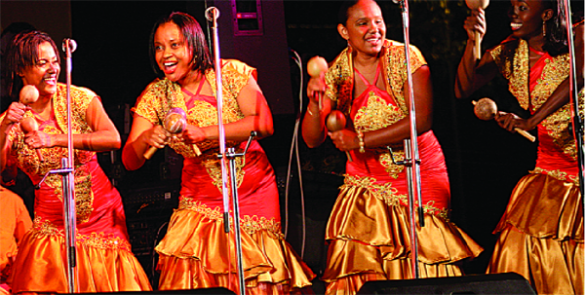The following Michelle Loubon article was published in The Trinidad Guardian, Dec. 23, 2012.
Trinis know Christmas time is just around the bend when the airwaves echo with beloved classics Around My Christmas Tree (1978) and Sha-la-la Christmas Song (1976). The evergreens were composed and sung by retired tax auditor Lennox Gray. Unconsciously, Trinis sing the familiar refrain from the Christmas Tree. A popular line goes “Laughing children tug at Mr Santa/Teddy bears and dollies saying mama.”
Effortlessly, they slip into Sha La la’s Christmas Song and its instructions to “Tell your granny/Put the sorrel in the sun to dry/Make the pastelle/bake the ham and now do you know why.” Both ballad-type songs with a subtle hint of American pop icon Johnny Mathis styles have weathered four decades. They continue to enjoy a place of honour during the Yuletide season. The songs have morphed into Christmas staples like parang from Los Alumnos de San Juan and socaparang from greats like Baron and Kenny J. …
Tired of white Christmases
Reverting to the dynamic duo’s genesis, Gray made reference to the turbulent 1970s and the period of social unrest that characterised T&T society. “We have to put the songs in context. There was the revolution in the 1970s. Everyone was seeking or asserting their identity. A group of artistes from the period felt whenever they turned on the radio they were only getting carols like Hark the Herald Angels Sing and Joy To The World. They wanted music with local flavour, texture and appeal. They wanted something that was uniquely Trini. They were tired of the white Christmases. They started clamouring for local styled music,” added Gray.
A band of artistes started writing songs that reflected Trini society and culture. A typical Trini Christmas consists of black fruit cake, red wine, pastelles, ginger beer and sorrel. Gray captured this slice of Trini life in his gems.
“The society wanted songs that they could relate to. I consider myself to have been part of that movement. I was instrumental in creating that local expression,” said Gray. …
Reminiscing on his childhood, Gray said, “My mother was a staunch Catholic. When she regaled me with stories about the Nativity, I got a sense about the majesty of Jesus Christ. My mother had this way of making sense of Bible stories like Noah and the Ark or Jonah swallowed up by a whale.”
Another profound influence was his grandmother (Miss Ferguson) and her traditional methods of preparing Christmas fare. The air was redolent with freshly baked bread and cakes at the family home on Piccadilly Street, Port-of-Spain.
Gray said, “I remember how Miss Ferguson would put sorrel out on the bleach. It was meant for clothes. She would put crimson sorrel out in the blazing sunshine to dry on the galvanise. I don’t know why. I guess it would have made the sorrel taste sweeter.”
Next she made use of her trusty mortar and pestle. “There was an art to crushing it. She would not just boil it with the spices like cloves. She would crush the fruit to bring out the full flavour. Sorrel making was serious business,” added Gray.
As he grew into adulthood, Gray felt he had to archive these stories and experiences by “doing something special for the children.”
He said,“I was moved to do something special for them. Children love to get a hug or a gift from Santa. I think we all know Santa does not come down chimneys in the Caribbean. But we have clung to the Santa Claus tradition.
“The jolly man in the red suit bearing gifts. It stemmed from the religious atmosphere which my mother had created. I had no idea what it would be. I had no idea whether the songs would succeed. But the rest is history.”
While Gray continues to receive tremendous kudos on the frontline, he felt applause should also go to pilot/engineer Max Serrao and Jason for their input into the sounds of the songs. They worked tirelessly on perfecting their craft. “Studios did not have all the hi tech equipment that artistes can make use of now. If a note was wrong, the engineer had to literally cut the tape and join it back. It was a labour of love to work with these guys.”
For the full and original article: Christmas evergreens Lennox Gray’s songs have weathered four decades | The Trinidad Guardian Newspaper.
